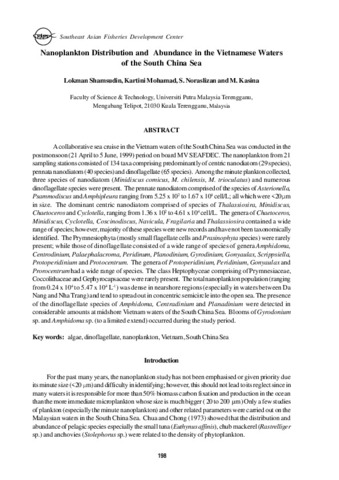| dc.contributor.author | Shamsudin, Lokman | |
| dc.contributor.author | Mohamad, Kartini | |
| dc.contributor.author | Kasina, M. | |
| dc.date.accessioned | 2019-01-18T08:25:06Z | |
| dc.date.available | 2019-01-18T08:25:06Z | |
| dc.date.issued | 2001 | |
| dc.identifier.citation | Shamsudin, L., Mohamad, K., & Kasina, M. (2001). Nanoplankton distribution and abundance in the Vietnamese waters of the South China Sea. In Proceedings of the Fourth Technical Seminar on Marine Fishery Resources Survey in the South China Sea, Area IV: Vietnamese Waters, 18-20 September 2000 (pp. 198-232). Bangkok, Thailand: Secretariat, Southeast Asian Fisheries Development Center. | en |
| dc.identifier.isbn | 9747604833 | |
| dc.identifier.uri | http://hdl.handle.net/20.500.12066/4375 | |
| dc.description.abstract | A collaborative sea cruise in the Vietnam waters of the South China Sea was conducted in the postmonsoon (21 April to 5 June, 1999) period on board MV SEAFDEC. The nanoplankton from 21 sampling stations consisted of 134 taxa comprising predominantly of centric nanodiatom (29 species), pennata nanodiatom (40 species) and dinoflagellate (65 species). Among the minute plankton collected, three species of nanodiatom (Minidiscus comicus, M. chilensis, M. trioculatus) and numerous dinoflagellate species were present. The pennate nanodiatom comprised of the species of Asterionella, Psammodiscus and Amphipleura ranging from 5.25 x 102 to 1.67 x 104 cell/L; all which were <20?m in size. The dominant centric nanodiatom comprised of species of Thalassiosira, Minidiscus, Chaetoceros and Cyclotella, ranging from 1.36 x 102 to 4.61 x 104 cell/L. The genera of Chaetoceros, Minidiscus, Cyclotella, Coscinodiscus, Navicula, Fragilaria and Thalassiosira contained a wide range of species; however, majority of these species were new records and have not been taxonomically identified. The Prymnesiophyta (mostly small flagellate cells and Prasinophyta species) were rarely present; while those of dinoflagellate consisted of a wide range of species of genera Amphidoma, Centrodinium, Palaephalacroma, Peridinum, Planodinium, Gyrodinium, Gonyaulax, Scrippsiella, Protoperidinium and Protocentrum. The genera of Protoperidinium, Peridinium, Gonyaulax and Prorocentrum had a wide range of species. The class Heptophyceae comprising of Prymnesiaceae, Coccolithaceae and Gephyrocapsaceae were rarely present. The total nanoplankton population (ranging from 0.24 x 104 to 5.47 x 104 L-1) was dense in nearshore regions (especially in waters between Da Nang and Nha Trang) and tend to spread out in concentric semicircle into the open sea. The presence of the dinoflagellate species of Amphidoma, Centradinium and Planadinium were detected in considerable amounts at midshore Vietnam waters of the South China Sea. Blooms of Gyrodonium sp. and Amphidoma sp. (to a limited extend) occurred during the study period. | en |
| dc.language.iso | en | en |
| dc.publisher | Secretariat, Southeast Asian Fisheries Development Center | en |
| dc.subject | Viet Nam | en |
| dc.subject | South China Sea | en |
| dc.title | Nanoplankton distribution and abundance in the Vietnamese waters of the South China Sea | en |
| dc.type | Conference paper | en |
| dc.citation.spage | 198 | |
| dc.citation.epage | 232 | |
| dc.subject.asfa | community composition | en |
| dc.subject.asfa | geographical distribution | en |
| dc.subject.asfa | ecological associations | en |
| dc.subject.asfa | abundance | en |
| dc.subject.asfa | check lists | en |
| dc.subject.asfa | plankton | en |
| dc.subject.asfa | nannoplankton | en |
| dc.subject.asfa | Algae | en |
| dc.citation.conferenceTitle | Proceedings of the Fourth Technical Seminar on Marine Fishery Resources Survey in the South China Sea, Area IV: Vietnamese Waters, 18-20 September 2000 | en |

